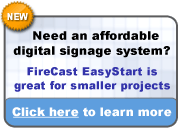"Ground-floor digital displays are ideal for just about any brand that wants to reach people on the go," adds [store window advertising company WindowGain COO Prem Hira]. Benefits specific to digital displays include real-time information. For example, the Boston.com spots actually pull news, weather, etc. from the boston.com web site.
It's easy to see the appeal for ad buyer and real estate owner alike. For the ad buyer, there are few better places to make an appeal than at eye-level. And the sizes of the displays that can be used are limited to the sizes of the store windows: in other words, they're huge, and very eye-catching. For the real-estate owner, they get to (potentially) make some money at a low cost and low risk, using assets that might otherwise simply be posting a loss.The economy's loss may well be a boon for companies like WindowGain. The International Council of Shopping Centers predicts that store closings may total 6,500 for 2008, or about 1% of existing stores, which would be the highest since 2001.
On the other hand, I once heard a story (not sure if it's true or not) that several of the buildings in Times Square are actually empty inside. As the story goes, the landlords and building owners have found it so lucrative to simply sell their facades to advertisers, that it's not worth the hassle of getting tenants, collecting rent, handling build-out costs and generally dealing with the insides of the buildings at all.
It's a little scary when advertising becomes the primary revenue source for a very staid, traditional business like that. I guess it's better than going bankrupt, though :)
Tags: digital signage, out-of-home advertising


 Here's something I haven't seen done before. As Dave Weinfeld
Here's something I haven't seen done before. As Dave Weinfeld  Subscribe to this blog
Subscribe to this blog Follow Bill Gerba on Twitter
Follow Bill Gerba on Twitter